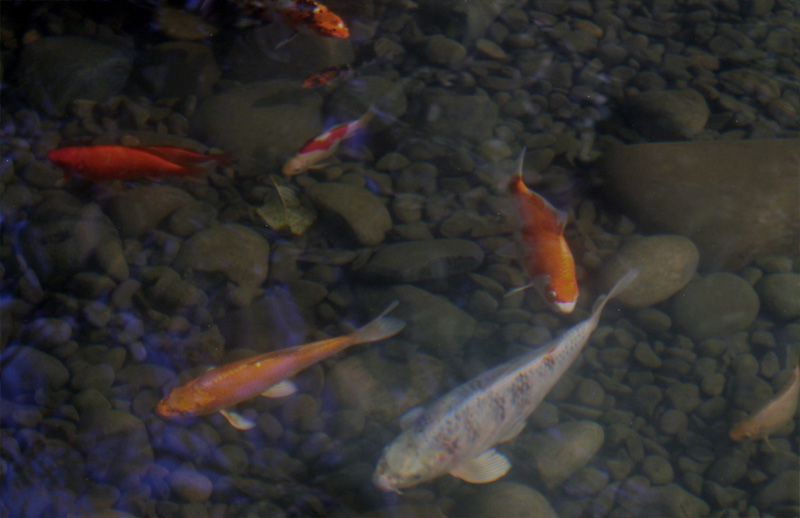Ponds can be a beautiful addition to your landscape. With their tranquil sounds and beautiful fish they can really enhance your outdoor living environment.
What to do when suddenly your once peaceful retreat turns into a quagmire of pea soup?
Ponds are a complex eco system and as such there is no one answer to fix the problem. Anyone who tells you there is, “just add this miracle chemical” is trying to sell you something. Algae is always going to be present in a healthy pond, however, not to the degree that it prevents you from seeing the fish you’ve so carefully cultivated.
Algae’s need two things to thrive, nutrient, (uneaten fish food and fish waste) and sunlight. Take away either of those things and your pond should clear up. It’s never going to be absolutely pristine with no algae growth unless you eliminate all biological living creatures and regularly add bleach to the system. But what fun is that? Isn’t the whole purpose behind a pond to enjoy the living ecosystem in your yard? The problem of algae in the pond is a multi faceted ‘fix’. The first step is to cover a large percentage of the open pond area with shade. This can be done by planting larger trees and shrubs around the periphery of the pond as well as adding water plants to the pond itself. Shelves can be added along the ponds edges as well as submersed milk crates or cinder blocks make great platforms for plants. The edition of bottom dwelling plants weighted with a rock, such as elodea and anacharis aid in the oxygenation of the pond as well as becoming a good natural food source for the fish. Floating plants such as water hyacinths, water lettuces and lilies can be had at most pond store for a reasonable price. These plants are also beautiful, adding texture and color to help soften the rocky pond edges, creating a more natural look.
Not only do these plants shade the pond from the sun and help with oxygenation, they also take up the excess nutrient in your water to feed themselves thus making them a double edged helper in the fight against the dreaded pea soup algae!
If the algae is persistent and occurs later in the year it is usually a symptom of an imbalance in the pond. This is where water test kits become a valuable tool to help you decide what the next steps should be to clear the pond.
Water temperature should be assessed, as well as CO2 levels, phosphate, ammonia and nitrate levels should also be considered. If any or all of these are higher than optimal it’s probably a contributor to your algae issue. The addition of a biological filter and leaf catching filter in addition to retarding your feeding schedule will all help to reduce the rate at which these levels climb bringing your pond back into balance. Be advised that nothing is going to be an over-night quick fix. As with all things in nature these things take time.
In addition to adding these algae fighting methods, a good water change of the pond, of about of the water should be implemented. Removing the lion’s share of the visible algae by hand, using a suction device, a screened pole and yes even your hands to get out as much algae as possible. When refilling the pond make sure that you refill it slowly and add a judicious amount of your favorite de-chlorinator. Remember to clean the screens and filter material in your leaf catcher to remove large debris on a regular basis.
When flushing the biological filter, which I recommend not be done more than twice a year, the addition of pre-bottled biological conditioner should be added to boost the beneficial bacterial residing in the bio-filter.
If the CO2 levels are high in your pond you may want to consider an aeration device in addition to your waterfall to help increase oxygen levels and surface agitation. Algae thrives in a poorly oxygenated water.
Though I don’t advocate the use of chemical ‘fixes’ in the pond, some can beneficial if used in the correct manner and judiciously. Many people fall prey to the claims on the bottle of a magical overnight cure which is both not realistic and can cause both over use and over dependence on chemicals. That being said, the use of barley extracts, barley bales or barley mattes can be helpful. When broken down the barley bales emit a naturally occurring chemical that inhibits that growth of hair and pea soup algae’s, further it helps to ‘clump’ the algae for later removal. There are also chemicals that can be added prior to the water change to help clump the algae together for easy removal. The best way to use these is sparingly, following the directions and if used at least 24 hours prior to the water change.
Lastly, though I’m not in love with the idea, UV lights can be added to most commercially sold biological and leaf catching skimmer filters. These lights while expensive can help clear an algae bloom fairly quickly, but should be used only in well established ponds as the lights don’t discriminate between killing beneficial, healthy bacteria, and harmful algae cause bacteria.
They kill them all with great efficiency, causing the pond to be out of balance once again. Be mindful that a large algae die off can cause just as many issues as the algae itself!
Doing things slowly, with caution and in the most natural way will ensure a healthy relatively algae free pond for you and your family to enjoy for years to come!






